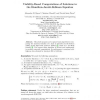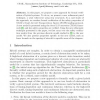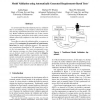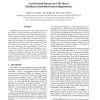104
Voted
HYBRID
2007
Springer
15 years 4 months ago
2007
Springer
Abstract. A self-triggered control task is one in which the task determines its next release time. It has been conjectured that self-triggering can relax the requirements on a real...
121
Voted
HYBRID
2007
Springer
15 years 4 months ago
2007
Springer
Abstract. This article proposes a new capture basin algorithm for computing the numerical solution of a class of Hamilton-Jacobi-Bellman (HJB) partial differential equations (PDEs)...
HYBRID
2007
Springer
15 years 4 months ago
2007
Springer
100
Voted
HYBRID
2007
Springer
15 years 4 months ago
2007
Springer
Abstract. In this paper, we propose a new approach for formal verification of hybrid systems. To do so, we present a new refinement proof technique, a weak refinement using step in...
HYBRID
2007
Springer
15 years 4 months ago
2007
Springer
We study the possibility to steer the state of a single-input single-output linear switched system to the origin in finite time by output feedback with finite memory. We show that ...
103
click to vote
HASE
2007
IEEE
15 years 4 months ago
2007
IEEE
In current model-based development practice, validation that we are building a correct model is achieved by manually deriving requirements-based test cases for model testing. Mode...
99
Voted
HASE
2007
IEEE
15 years 4 months ago
2007
IEEE
Embedded systems are used for critical applications that must adhere to safety constraints. Developers of these systems face three key challenges when attempting to apply existing...
117
click to vote
HASE
2007
IEEE
15 years 4 months ago
2007
IEEE
We present a tool-supported approach to the validation of system-level timing properties in formal models of distributed real-time embedded systems. Our aim is to provide system a...
96
Voted
HASE
2007
IEEE
15 years 4 months ago
2007
IEEE
Automated verification plays an important role for high assurance software. This typically uses a pair of pre/post conditions as a formal (but possibly partial) specification of e...
91
Voted
HASE
2007
IEEE
15 years 4 months ago
2007
IEEE
Recently, many routing protocols and applications for mobile ad hoc networks have been proposed. However, most of them are tested through the simulation experiments, but are not d...




